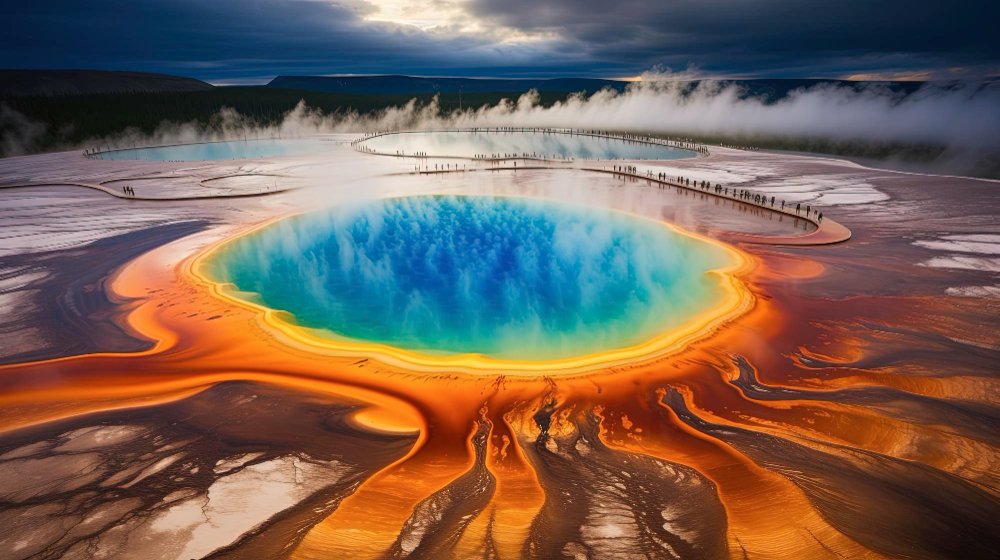Tired of the daily grind? Imagine slipping into a secluded hot spring, steam swirling around you, the world’s stress melting away. Discover hidden, hot water springs where ultimate relaxation is yours for the taking.
⫸ Introduction to Hot Springs
From bubbling mud pots to steaming turquoise pools, hot springs captivate our imagination. These natural wonders offer a unique blend of relaxation, awe-inspiring beauty, and a link to the Earth’s raw power. Let’s dive into the fascinating world of hot springs, exploring what they are and their profound role throughout history.
What are hot springs?
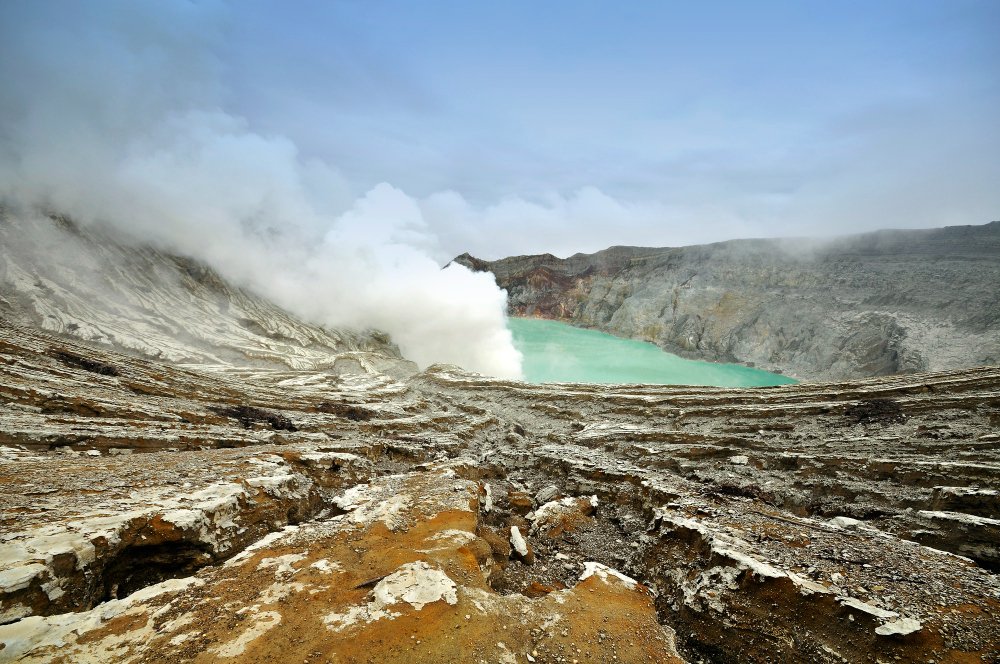
- Hot springs are naturally occurring pools of water heated by geothermal activity deep within the Earth’s crust.
- This heat is generated by magma (molten rock) or hot rocks deep below the surface.
- Hot spring water can range from comfortably warm to scalding hot – always check the temperature before entering!
- They often possess a distinct mineral content, sometimes creating vibrant colors or a noticeable sulfurous smell.
Brief history and cultural significance of hot springs
- Hot springs have been revered for their perceived healing and spiritual properties for millennia.
- Native American tribes held hot water springs sacred, utilizing them for medicinal and ceremonial purposes.
- Ancient Romans and Greeks developed elaborate bathhouse cultures around hot springs.
- Traditional onsen (hot spring baths) remain integral to relaxation and social customs in Japan.
- Today, hot water springs attract tourists worldwide, offering a chance to unwind amidst nature’s splendor.
⫸ The Science Behind Hot Springs
Hot springs aren’t just a relaxing escape but a fascinating window into the incredible forces shaping our planet. Let’s dive into the science that makes these natural wonders possible.
How hot springs form (geothermal activity)
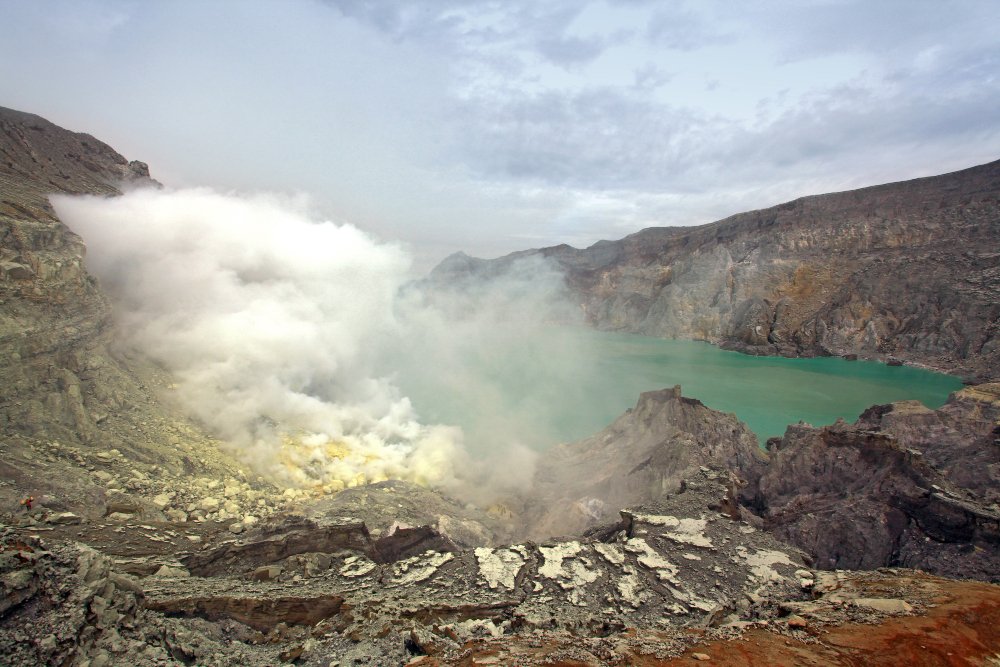
- Earth’s interior is incredibly hot, especially the deeper layers. This heat radiates outward towards the surface.
- Groundwater seeps deep underground through cracks and faults. As it gets closer to hotter rocks, it heats up.
- This heated, less dense water rises back towards the surface. Depending on the depth, it can range from comfortably warm to scalding hot.
- A hot water spring is born when this hot water finds a path to the surface!
Mineral composition of hot springs
- Hot springs aren’t just hot water – they’re a mineral cocktail! As water travels underground, it dissolves minerals from the surrounding rocks.
- Common minerals found in hot springs:
- The specific mineral makeup gives hot springs different colors, smells, and potential therapeutic properties.

Environmental considerations (sustainability and protection)
- Hot springs are fragile ecosystems. Overuse can deplete the water source or alter water temperatures, harming delicate life.
- Pollution is a serious threat. Chemicals, trash, and even soaps can harm the delicate balance of the water.
- Responsible tourism is key: stick to designated areas, pack out what you pack, and respect the natural environment.
Magma and Groundwater Interaction
- Magma (molten rock) sits closer to the surface in volcanically active areas, superheating groundwater.
- This creates the hottest hot springs and other geothermal features like geysers.
- Even away from volcanoes, the Earth’s natural heat gradient is enough to create the more common warm springs.
⫸ Types of Hot Springs
These springs aren’t just about warm water and relaxation – they come in a spectacular variety of forms shaped by unique geological processes. Let’s dive into some of the most fascinating types:
Geysers
- Geysers are the rockstars of the hot spring world! These explosive wonders occur when groundwater gets superheated and trapped, building pressure until it spectacularly erupts in a column of hot water and steam. Yellowstone’s Old Faithful is the most famous example.
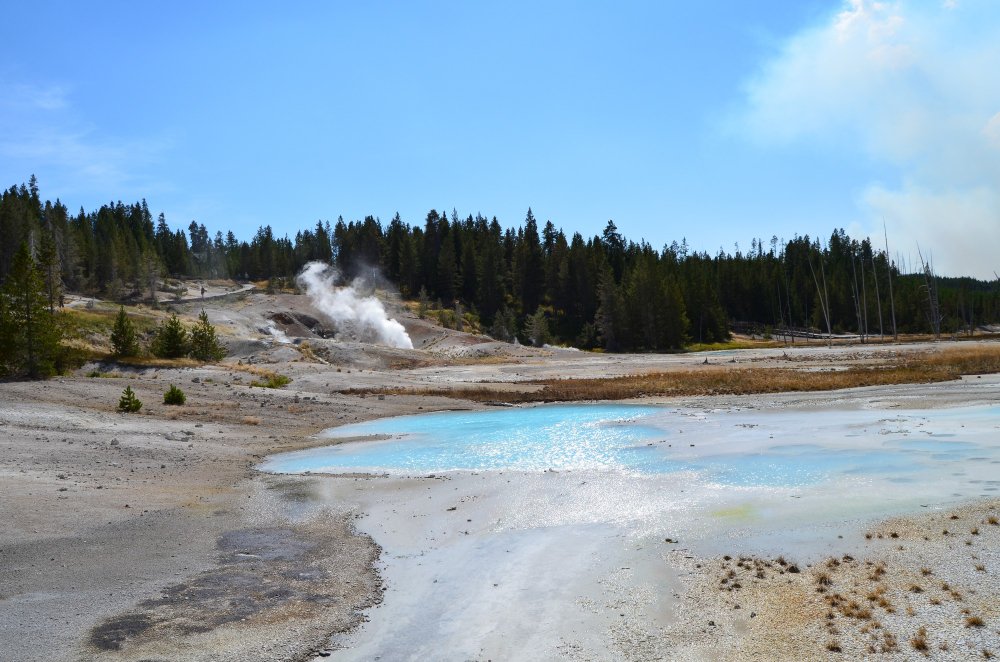
Fumaroles
- These steamy vents release hot gases from deep within the earth’s crust. Often found in volcanic areas, fumaroles hiss and whistle, sometimes smelling strongly of sulfur (think rotten eggs!). They’re a dramatic reminder of the raw power beneath our feet.
Mudpots
- Mudpots are a gooey, bubbling mess—and strangely captivating! Acidic hot water dissolves the surrounding rock, forming a thick mud slurry. The mud splatters often blur and splatter, creating a landscape that feels almost otherworldly.
Travertine Terraces
- Hot springs rich in minerals like calcium carbonate create stunning formations called travertine terraces. These cascading, step-like pools gleam with vibrant colors from white to orange and even turquoise, offering a breathtaking and unique bathing experience.
⫸ The Benefits of Soaking in Hot Springs
Soaking in a hot water spring isn’t just a relaxing treat; it offers a range of potential benefits for your physical and mental well-being. Let’s dive into how these steaming pools of mineral-rich water work their magic:
Physical Health Benefits
- Improved circulation: The warmth of a hot spring dilates blood vessels, improving blood flow throughout your body. This can help lower blood pressure and deliver oxygen and nutrients more efficiently.
- Muscle pain relief: Heat therapy has long been used to soothe sore muscles. These springs offer natural warmth and buoyancy, taking pressure off your joints for a double dose of relief.
- Skin conditions: Minerals like sulfur, silica, and zinc in these springs may benefit conditions like eczema, psoriasis, and dry skin.
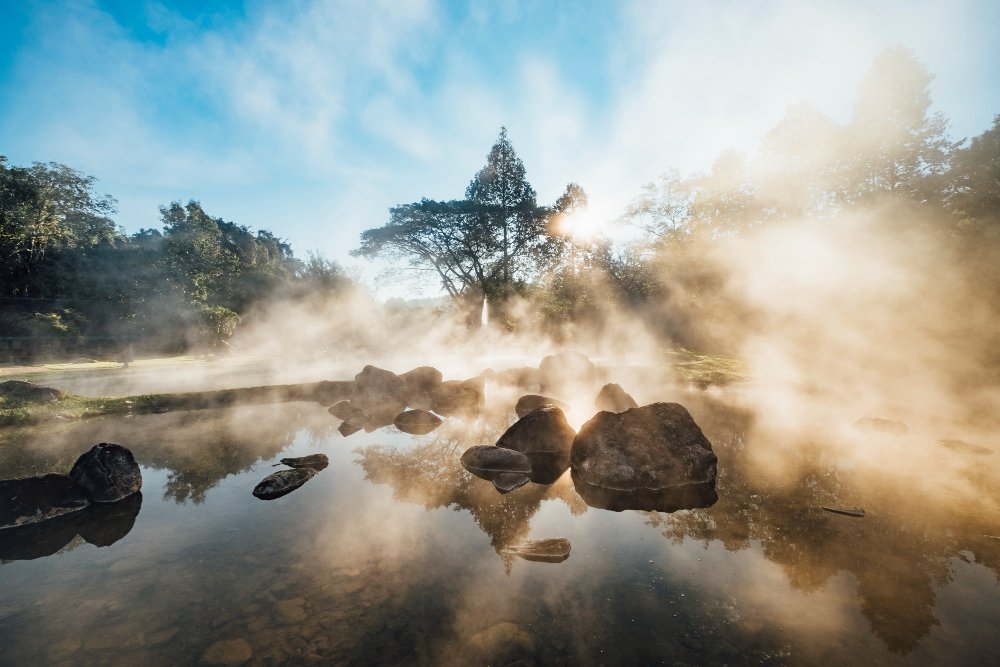
Mental Health Benefits
- Stress Reduction: The combined effect of warmth, buoyancy, and a beautiful natural setting can work wonders in melting away stress. The minerals in the spring water also contribute to a sense of relaxation.
- Improved Sleep: Soaking in such springs before bed can help you wind down. As your body temperature cools afterward, it signals your brain that it’s time for sleep.
Important Safety Considerations (things to be aware of)
- Stay hydrated! Drink water before, during, and after soaking.
- Test the water temperature before getting in.
- Limit your soak time, especially on your first visit.
- Be aware of slippery surfaces and potential heat-related health issues.
⫸ Famous Hot Springs Around the World
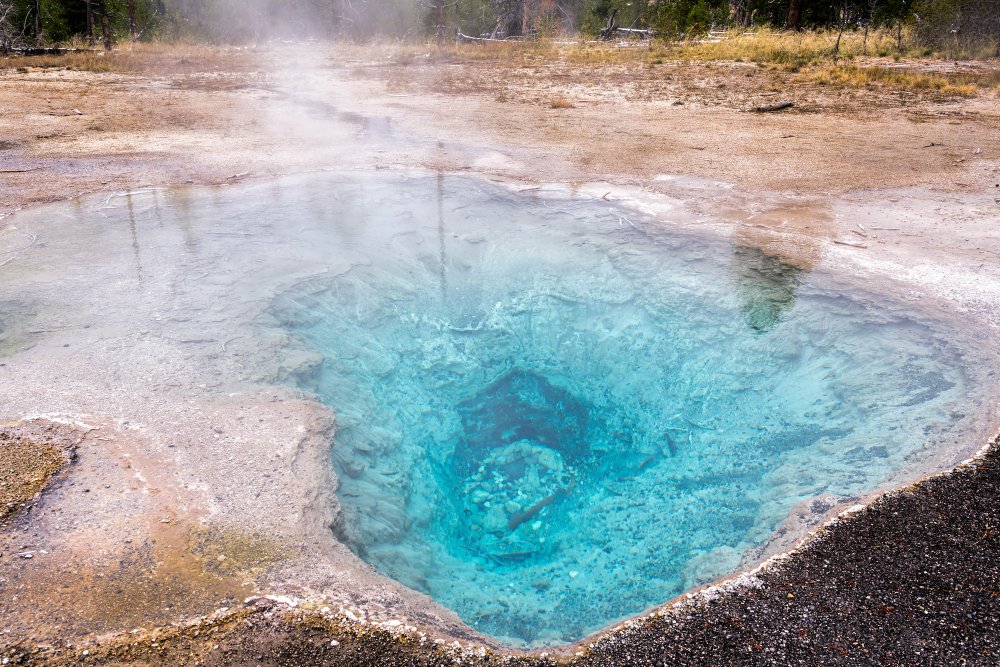
Hot springs bubble forth across the globe, each with its allure. From the milky blue waters of Iceland to the steaming travertine terraces of Turkey, let’s embark on a journey to some of the world’s most captivating hot springs.
Blue Lagoon (Iceland)
- Iceland’s Blue Lagoon is a geothermal icon. Its milky blue waters, rich in silica and minerals, shimmer against a backdrop of volcanic rock.
- The lagoon’s reputation for soothing skin conditions draws visitors worldwide.
- Luxurious amenities, like in-water massages and silica mud masks, enhance the experience.
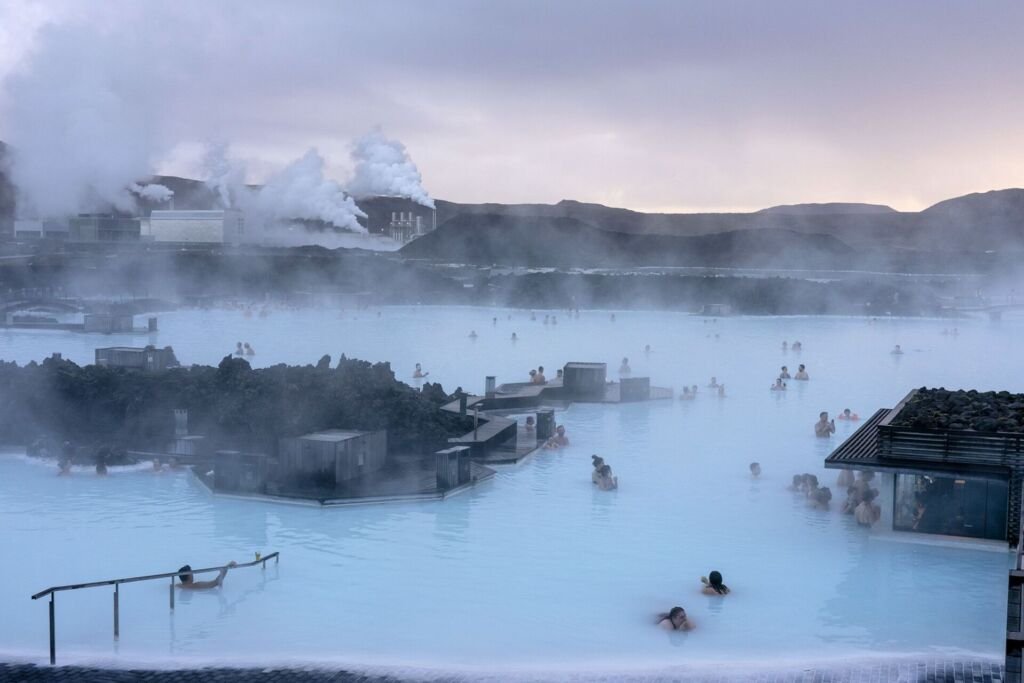
Pamukkale (Turkey)
- Pamukkale, meaning “cotton castle” in Turkish, is a natural wonder. Brilliant white travertine terraces spill over with mineral-rich, steaming water.
- These formations have developed over centuries as hot springs cascade down the hillside.
- Visitors can wade in the warm pools and admire the ruins of the ancient Roman city of Hierapolis nearby.
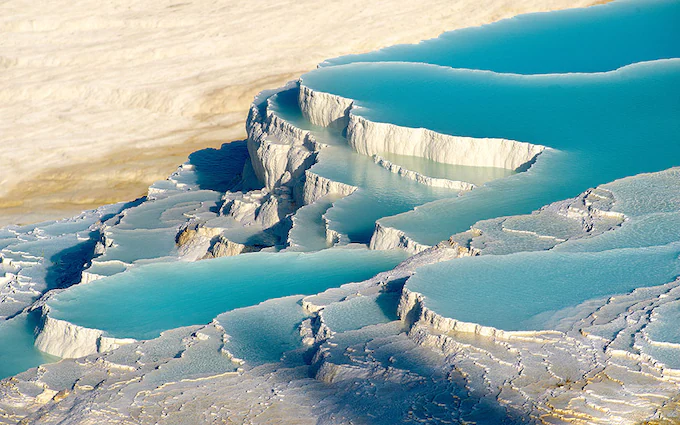
Takaragawa Onsen (Japan)
- Immerse yourself in onsen culture at Takaragawa Onsen, a traditional Japanese hot spring resort in a picturesque valley.
- Multiple outdoor baths offer breathtaking river views. Strict rules preserve the tranquility and respect for this bathing tradition.
- Takaragawa Onsen provides a truly authentic Japanese hot spring experience.
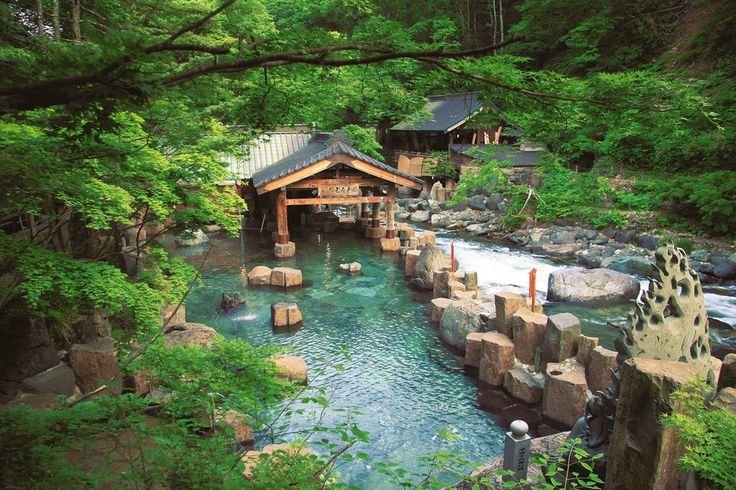
Yellowstone National Park (USA)
- Yellowstone National Park boasts a vast geothermal wonderland, including thousands of hot springs. The Grand Prismatic Spring is its star with vibrant rings of color radiating from the steaming center.
- While many springs are too hot for soaking, designated areas offer a safe way to experience the warmth.
- Yellowstone’s hot springs showcase the earth’s raw power and dynamic beauty.
A less internationally famous but interesting option
- Saturnia Hot Springs (Italy): These cascading waterfalls in Tuscany offer a free, natural hot spring experience. Legend says the god Jupiter’s lightning bolts formed them.
- Their sulfuric waters and warm temperatures are said to have therapeutic properties.
- The picturesque setting adds to Saturnia’s allure as a relaxing, natural escape.

⫸ Hot Spring Etiquette: Preserving the Experience for Everyone
Enjoying hot springs is a privilege, and it’s essential to remember that these natural wonders are shared spaces. Following basic etiquette, you can protect the environment, ensure a pleasant experience for fellow bathers, and prioritize your safety.
Respect for the environment
- Leave no trace principles: Pack out everything you bring in, including trash, food scraps, and any toiletries you may have used.
- Stay on designated paths: Wandering off-trail can damage delicate ecosystems surrounding hot springs.
- Avoid soaps or shampoos: These products can pollute the water and harm the natural mineral balance.
Respect for other bathers
- Noise levels: Hot springs are meant for relaxation. Keep conversations at a low volume and avoid loud music or disruptive behavior.
- Shared space: Be mindful of personal space. Don’t crowd others, and be welcoming to newcomers.
- Hygiene practices: Shower or rinse off before entering the hot spring to remove sweat, lotions, or other products.
Safety considerations
- Checking water temperature: Dip a toe in before fully immersing yourself to avoid burns. Hot spring temperatures can vary greatly.
- Hydration: Drink plenty of water before, during, and after your soak to prevent dehydration.
- Time limits: Extended soaking isn’t advised. Take breaks to cool down, especially if you feel lightheaded.
⫸ Hot Springs and Culture
Throughout history and across the globe, hot springs have held a special place in human cultures. From ancient rituals to modern-day wellness destinations, these naturally heated waters have shaped traditions, fostered communities, and inspired a deep appreciation for the wonders of the natural world. Let’s dive into their cultural significance:
Historical Significance of Hot Springs
- Healing Havens: Many ancient civilizations revered hot springs as sacred places of healing. Romans, Greeks, and Native Americans believed that mineral-rich waters held medicinal properties to cure ailments.
- Spiritual Centers: Hot springs often served as sites for religious rituals and purification ceremonies. Japanese Shinto traditions link hot springs to spiritual cleansing.
- Social Hubs: Public bathhouses built around hot springs became vital community centers, places to socialize, conduct business, and relax.
Bathing Traditions in Different Cultures
- Japan’s Onsen Culture: Soaking in ‘onsen’ is deeply ingrained in Japanese society. Strict etiquette governs these communal baths, emphasizing respect, cleanliness, and the meditative aspects of bathing.
- Turkish Hammams: These elaborate bathhouses blend Roman and Eastern influences. They offer a multi-step bathing ritual involving steam rooms, massage, and relaxation areas.
- Icelandic Hot Pots: Iceland’s geothermal landscape is dotted with hot springs. Even amidst the snow, soaking in these natural pools is a beloved Icelandic pastime.
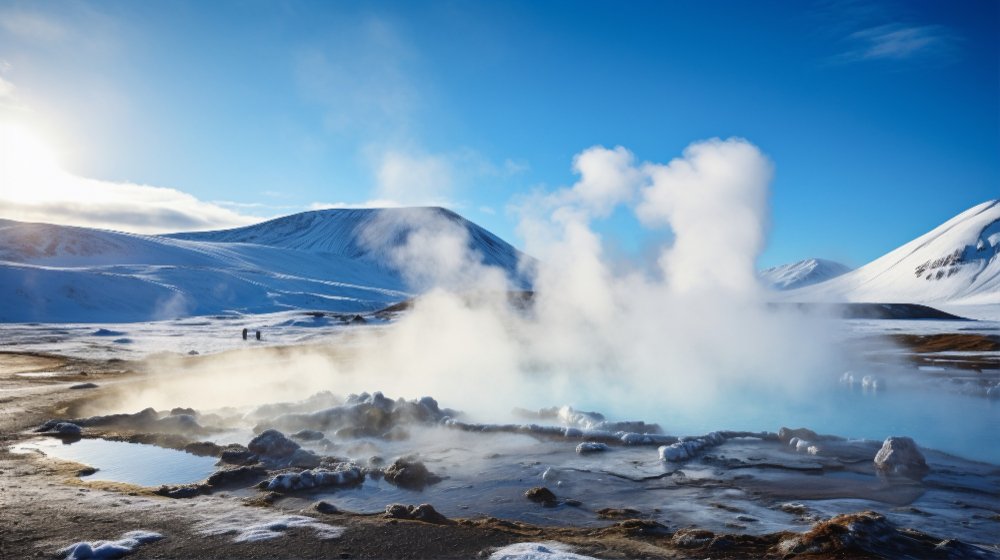
Modern-day Hot Spring Tourism
- Wellness Retreats: Hot springs have transformed into destinations for relaxation, spa treatments, and holistic wellness experiences.
- Adventure Tourism: Remote hot springs offer a unique draw for hikers, campers, and those seeking off-the-beaten-path adventures.
- Sustainable Tourism: A growing focus on responsible tourism emphasizes preserving hot springs and their surrounding ecosystems.
⫸ Conclusion
- Hot springs are a testament to the Earth’s dynamic nature, offering a unique blend of relaxation, wonder, and potential therapeutic benefits.
- Whether you seek a hidden gem nestled in nature or a renowned hot spring steeped in history, a perfect soak awaits you.
- Remember, responsible enjoyment is key to preserving these natural treasures.
- So, embrace the warmth and let the world’s worries melt away in the embrace of a hot spring.

